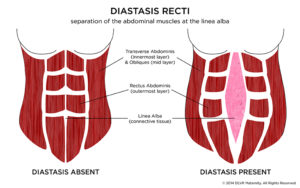Can’t lose the mummy tummy? You could have a diastasis recti.
In my last post I wrote about easing back into a realistic doable fitness routine post pregnancy. One of the things that I had mentioned was that it is important to exercise safely. Pregnancy is a time of many physical changes, while it is important to remain physically active during and after pregnancy it is also important to understand these changes and modify or alter your fitness routine accordingly.
During pregnancy your posture tends to change. The increasing weight around your mid-section tends to pull your lower back into a hyper extension that can cause lower back pain both during and after pregnancy. This pain can get worse post pregnancy when your hormones are still in flux and ligaments are still in a relaxed state and now you have the additional task of caring for your baby. Constant bending, lifting during bath times, diaper changes carrying the baby on your hips all contribute to the stress on your lower back.
Pilates helps by strengthening muscles that support not just your back but also your pelvis restoring a more neutral alignment of the spine and thereby alleviating back pain.
One of the most common mistakes new mothers make in a bid to lose the “mummy tummy” is to do endless crunches or sit ups. Not only can traditional sit ups hurt your already weak lower back but it can actually make your tummy pooch out even further.
This is due to a condition called diastasis recti.
Your abdominal muscles are layered with the transversus abdominis being the deepest or inner most followed by the external and internal oblique muscles and the rectus abdominis or the 6 pack forming the outermost layer.
During pregnancy the increasing load around your tummy puts pressure on your abdominal muscles from the inside (intra-abdominal pressure) and this causes the thin connective tissue running vertically down the center of your torso from the sternum to your pubic bone to stretch out and the rectus abdominis muscles to separate this leaves the contents of the abdomen unsupported with very little to hold them in. This is what causes the permanently 5 months pregnant pooch that some women face many months and years after the baby.
(It is important to note here that a diastasis is possible even among men and infants. For men the reason is typically very weak core muscles made worse by heavy lifting and doing traditional sit ups or after surgery.)
The diastasis post pregnancy normally tends to shrink on its own but doesn’t in many cases.
In the next post I will be talking about how you diagnose if you have this condition and what you can do to heal it.
MOST COMMENTED